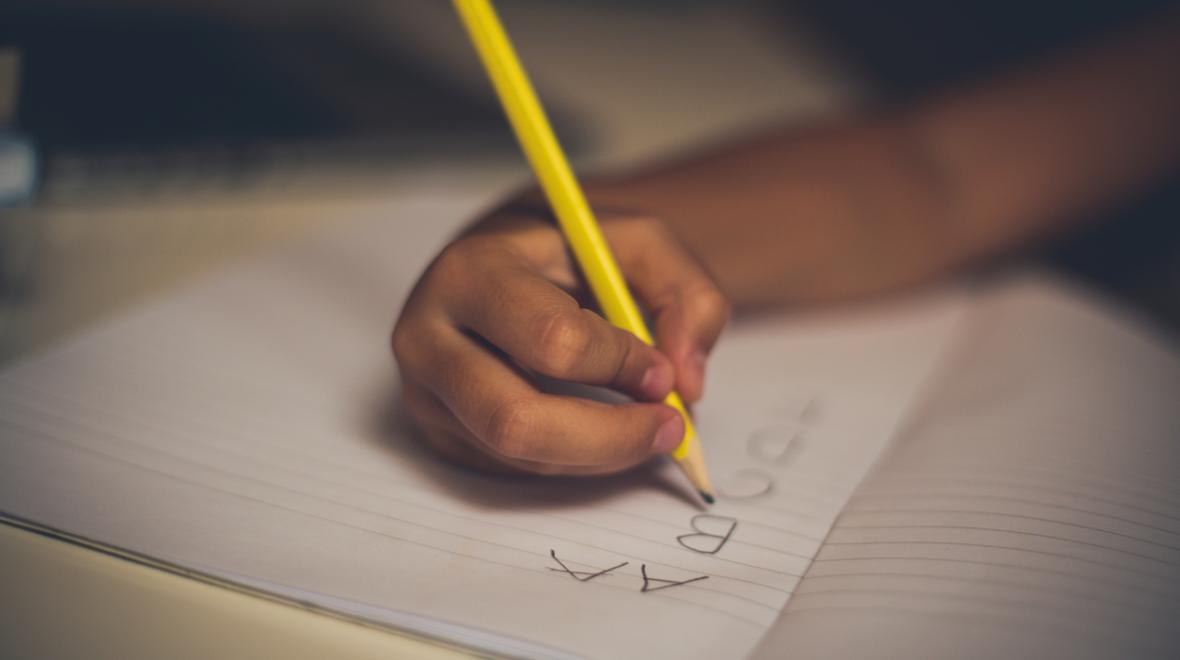
A few years ago, Seattle parents Michelle Lewis and Henry Underhill noticed that their 5-year-old son did not seem interested in learning letters or their sounds. At that same time, the boy’s 3-year-old brother was trying to write his name. The parents saw the difference, but at first they weren’t terribly concerned about their older son.
“Initially, we chalked it up to lack of interest,” Lewis says. “He seemed to be developing normally in all other areas. He loved to draw and listen to stories, and was genuinely excited to go to his Montessori preschool each day.”
By kindergarten, the boy’s classmates were attempting to cobble together a whole written sentence, yet he labored to get the letters of a single word from his head to his hand to his paper. Difficulty with a summer reading and writing program left their usually easygoing son “completely stressed out,” Lewis says.
On the other hand, it’s the 21st century, when the keyboard is king. So a child is struggling to learn to write letters. Does this even matter? It’s a valid question in our technology-driven lives, when many of us turn to Siri or Amazon Fresh instead of writing a grocery list by hand. “A lot of people say that we shouldn’t bother with handwriting because there’s so much computer use and keyboarding,” says Cherie Duval-White, an occupational therapist with Seattle Children’s Hospital.
Handwriting and literacy
But handwriting does matter — profoundly, according to Virginia Berninger, Ph.D., a professor of educational psychology at the University of Washington. In her recent article for Principal magazine, titled “Strengthening the Mind’s Eye: The case for continued handwriting instruction in the 21st century,” Berninger lays out what her research (and others’) has shown.
“Contrary to popular belief,” Berninger writes, “handwriting is not merely a motor skill; it is also a written language skill.” In other words, learning handwriting is a key component to literacy.
So don’t trade those pencils for iPads just yet.
Handwriting instruction, says Berninger, trains the “orthographic loop of working memory.” This is the connection between letters and words we see in our mind’s eye and the hand movements required to write letters and words on paper. This orthographic loop, she explains, is what enables automatic letter writing — our ability to write and spell without effort.
Further, research shows that making letters by hand gives kids better perception of those letters while they’re learning to read than does selecting letters on a keyboard. All this, Berninger explains, is what supports the essential literacy skills of reading and writing.
With all this riding on children learning their letters, what’s the best way to teach young kids to write?
“When kids get to elementary school, almost half their day is spent with their pencil and their paper,” Duval-White says. But for young kids, she adds, simply sitting at a desk is not the most effective way to learn to write — kids need to do more. “Young learners learn using all of their senses,” she says.
Duval-White says that the best handwriting curriculums include movement activities, such as drawing giant letters in the air with arms, having kids make letters with their bodies, or forming letters by assembling straight and curved block pieces. Toys and games that develop fine motor skills and songs about letters and their sounds also help. These activities tap into the different ways kids learn.
“When you do all those things,” Duval-White says, “you have many different memories of how to retrieve [letter] information and put things together.”
Signs of dysgraphia
For many kids, this type of comprehensive handwriting instruction works as designed, and their writing and reading both flourish. But for kids such as Lewis and Underhill’s son, trying to learn handwriting brought only frustration.
After he was evaluated, he was diagnosed with dysgraphia, a learning disorder that affects writing abilities. According to the International Dyslexia Association, children with dysgraphia struggle with the “storing and analysis” of written words as well as planning the hand movements needed to make letters. While dyslexia and dysgraphia are not the same, the two disorders can occur together — as was the case for Lewis and Underhill’s son — or independently.
Lewis, a former reading teacher and current literacy director, says her professional expertise helped her to recognize the signs early. On its website, the National Center for Learning Disabilities (ncld.org) publishes a list of warning signs of dysgraphia in early writers. These include an awkward pencil grip or body position, avoidance of writing and drawing activities, difficulty forming letter shapes and the inability to draw or write within lines.
Movement-based activities, such as those described by Duval-White, can help a child with dysgraphia, as can practicing motor activities such as connecting dots to make letters, tracing letters with fingers, and modeling a teacher’s formation of letters. In addition, the National Center for Learning Disabilities suggests trying different pens or pencils to find a comfortable fit and using paper with embossed lines for sensory direction.
For Lewis and Underhill’s son, a school with a specialized, multisensory approach to teaching literacy was the best solution. After enrolling him, the parents saw his writing confidence improve significantly. “The best indicator of progress,” Lewis said, “was in the spring when he presented me with a book that he had written at home on his own.”
Learning to write: markers to watch for
- Babies and toddlers
Babies typically develop the pincer grip by age 1 year, and can hold a pencil or crayon. Toddlers can begin to manipulate a computer mouse. - Preschoolers
Preschoolers can make pencil strokes, copy lines and shapes, and imitate scribbling. Preschool-age children who encounter difficulty with motor skills and prewriting may also have oral language problems. - Kindergarten
In kindergarten, kids should be able to form “accurate and legible” letters. Students continue to practice motor and aural aspects of knowing, naming and forming letters, which contribute to handwriting fluidity.
“Strengthening the Mind’s Eye,” by Virginia W. Berninger, Ph.D., Principal magazine











